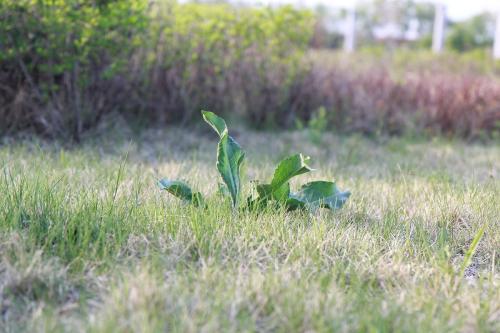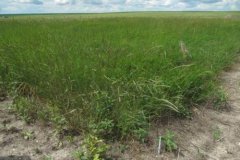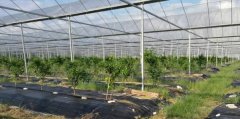How to control perennial malignant weeds: weed control methods of how to control malignant weeds
Weed control, how to grow crops, there will be the existence of weed problems, then how to control weeds? You know what? if you don't know, let's get to know it.
The disturbance of weeds to the normal growth of crops is different from that caused by pathogens and insects (pest), which often causes sudden and significant damage, and even has no harvest without proper prevention measures. therefore, monitoring the growth and decline of pest habitats in the field is a necessary means to achieve the level of economic control. However, the existence of weeds is synchronized with crops, and the effect on crops is gradual and sustained. Because the amount of weed seeds in the soil seed bank (soil seed bank) is already high, although the species and number of weeds in the field are changed because of climate, species of cultivated crops, degree of soil preparation, soil water content and the type and frequency of herbicide use, many weed seeds usually begin to sprout at the same time of sowing, sharing all natural and man-made resources in the field with crops. Until the completion of the life history to achieve the goal of racial succession.

With the characteristics of high seed yield and long dormant period, weeds have strong reproductive ability, and are easy to spread to other areas quickly with irrigation water, medium of cultivated crop seedlings, animal carrying and other factors. vegetative propagation stems will even spread to the whole region because of the cutting of agricultural machinery during soil preparation. In view of the talent of rapid spread and strong competitiveness of weeds, the impact on the agricultural production system mainly occurs in the growth inhibition before the crops are covered, and the seeds fall after the weeds bloom and bear fruit, thus increasing the seed content in the soil. Therefore, the prevention and control focuses on the early stage of crop growth, and even the weed management of pre-cropping or leisure fields will affect the control effect.
Weed Control in Organic cultivation
The main idea of organic agricultural management is to try to give full play to the original potential of farmland soil and nature, but modern agricultural management adopts a single crop cultivation system in order to pursue high yield and reduce production costs. the long-term hidden worries of the decline of soil vitality, the change of natural ecology, the decrease of provenance diversification and the deterioration of environmental quality caused by the massive application of chemical fertilizers and pesticides. The effect of herbicides on soil texture is especially better than that of other agricultural chemicals. However, the operation in line with the concept of organic cultivation is not a complete return to the ascetic-like farming methods of the old ancestors, but the combination of existing high-tech, reasonable production of safe agricultural products.
From the characteristics of weed occurrence and competition, it is not difficult to understand that weed control is an insurmountable problem in the implementation system of organic cultivation, because a large number of weed seeds already exist in the soil. Human beings do not hesitate to use a large number of pesticides to kill them in order to get the benefit of high yield, which seems to have achieved remarkable results in a short time, but it has changed the original ecological balance of nature for a long time. More efforts must be made to make up for the deficiencies caused.
Therefore, there is an urgent need to establish the concept of "weed management" to replace the traditional "eradication", that is, to achieve a balance between crop yield and quality and weed survival, combined with field operation and reasonable application of pesticides with short residual period during the sensitive growth period of crops. long-term continuous control or use of weeds to keep their occurrence within an acceptable range, which can not only provide a better growth space for crops. At the same time, it will not abuse drugs to pollute the environment and meet the principle of economic prevention and control.
At present, the commonly used non-pesticide weed control techniques, including water and dry field rotation with tillage system, or covering the field with rice or plastic cloth to inhibit the germination of weeds can reduce the occurrence of weeds on the field and the number of seeds in the soil. even maintaining the grass cultivation of low creeping weeds in the orchard can not only reduce soil moisture evaporation, but also reduce weed competitiveness under proper management. Cleaning and maintenance around the field and irrigation ditches can reduce the introduction of harmful seeds and vegetative forms. Perennial weeds with high harmful potential and difficult to control should be effectively controlled at the initial stage of discovery so as to slow down their spread rate.
In fact, in well-managed fields, the number of weed seeds in the soil will decrease year by year, the harm degree of weeds will also decrease, and the control operation tends to be simple and controllable. Compared with relying entirely on the application of pesticides, it is safe and free from the occurrence of resistant weeds. And the worries of soil fertility decline.
The ultimate goal of promoting organic agriculture is to achieve sustainable agricultural management. therefore, in the face of artificially identified "weed" plants, on the premise of avoiding the production and invasion of a large number of seeds, we should make rational use of various control techniques to prevent weed seeds or vegetative propagations. from the pollution of crop provenances, fertilizers, agricultural machinery and irrigation water, and to restrain the growth of weeds in the field, the most important thing is to grasp the level of control. To eliminate the concept of "not keeping an inch of grass", the implementation of organic cultivation is bound to be just around the corner.
The continuous occurrence of weeds in the crop cultivation system, its rapid spread and strong competitiveness have brought a great impact on agricultural production, from the proverb "weeds can not be eliminated, spring breeze still flourishes". You can deeply understand the helplessness of early farmers in weeding, but at present, farmers in Taiwan almost rely mainly on herbicides to control weeds, while ignoring how to cooperate with other non-pesticide integrated control techniques. In particular, preventive measures covering seed quarantine, in order to reduce the invasion and spread of weeds, combined with cultivation management system and the application of pesticides and other comprehensive control techniques, in order to achieve time-saving, labor-saving and economic management strategy.
- Prev

Ecological environment management: the distribution of weeds in non-cultivated land and the importance of protecting ecological environment
Weed ecology and distribution: we can see weeds everywhere, so there are a lot of weeds in the land we plant, so how do you control weeds? Is to buy herbicides? This is not ecological. If you want to be eco-friendly, you'd better be.
- Next

Net room greenhouse: the prevention and control of diseases and insect pests, what is the control method of diseases and insect pests?
Do you know the biological control of crop pests cultivated in the net room? What are the reasons for the occurrence of pests in the net room? What are the reasons for the difficulties in pest control in net rooms? What are the advantages of net room biological control? Let's take a look at it. Get to know it. From the past
Related
- A one-day flower show brings 130 million yuan in orders! Nanhai, this Phalaenopsis exhibition is amazing
- What do the flower language and meaning of Lutheran tree mean? Precautions for planting Lutheran tree
- Encounter Chaoshan Kongfu tea, not without this cup of Phoenix single clump
- The durian market in Vietnam and Thailand is flooded. The price of imported durian has plummeted by 30-40% in a month.
- Shanghai solved the problem of local vegetable supply by planting 80,000 mu of green leafy vegetables.
- Wageningen University has become the best agricultural university in the world for the seventh time in a row.
- The strongest export season of South African grapes is full of challenges, with exports to Russia falling sharply by 21%.
- Sri Lanka is on the verge of bankruptcy, "Tea for debt" Organic Agriculture Revolution aggravates the Food crisis?
- Turning waste into earthworm manure and worm manure into organic fertilizer-A new choice for auxiliary farming
- Organic rice growers shoulder the responsibility of nurturing agricultural talents! Yinchuan Sustainable Farm with Organic Life Camp

